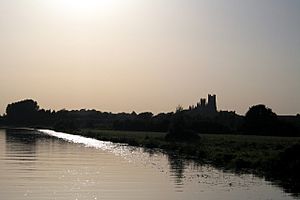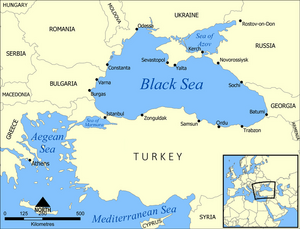Siward Barn facts for kids
Quick facts for kids
Sigeweard Bearn
|
|
|---|---|
| Occupation | Thegn and landowner-warrior |
| Years active | 1066–1087 |
| Known for | Fighting against William the Conqueror |
Siward Barn (also known as Sigeweard Bearn) was an important English nobleman, called a thegn, who lived in the 1000s. He was a wealthy landowner and a warrior. Siward is remembered for bravely fighting against William the Conqueror after the Normans took over England in 1066.
He joined the English resistance in the north of England in the late 1060s. Siward continued to fight until he was captured on the Isle of Ely in 1071. He was caught along with other famous English leaders like Bishop Æthelwine, Earl Morcar, and Hereward (often called "the Wake"). After his capture, Siward was put in prison.
He stayed in prison until 1087, when King William, who was very ill and thought he was going to die, ordered Siward to be set free. We don't know much about Siward's life after he was released. However, some historians believe he might have joined a special group of warriors called the Varangian Guard in a faraway city called Constantinople. There's even a story that he led a group of English people to start a new settlement near the Black Sea, which they supposedly named "New England."
Contents
Who Was Siward Barn?
It's a bit tricky for historians to figure out exactly who Siward Barn was. This is because there were many important people named Siward in England during the 1000s. His nickname, "Barn," is an Old English word that means 'descendant' or 'child.' This suggests that Siward came from a very important family, possibly even a royal one.
Historians have different ideas about his family. Some think he might have been related to the powerful Earls of Northumbria. Others believe he was connected to King Edward the Confessor. What we do know is that he was a significant figure with a lot of land before the Normans arrived.
Fighting William the Conqueror

In 1068, people in northern England started to rebel against King William's rule. The king was worried, so he marched north and built many castles in important towns like York and Lincoln.
In 1069, a fleet of ships from Denmark, led by the Danish king Sweyn Estridsson, arrived in England. This is when Siward Barn officially joined the fight. He teamed up with other English leaders, including Edgar the Ætheling (who wanted to be king of England) and Earl Waltheof. They joined forces with the Danes and marched to York. The people of York also joined them, making their army even bigger.
King William was very angry about this rebellion. He carried out a harsh campaign called the "Harrying of the North" in the winter of 1069-1070. He destroyed many villages and farms to stop the rebels.
Siward and other leaders later went to Scotland. In 1071, Siward, along with Bishop Æthelwine and Morcar, sailed back to the Isle of Ely. This island was a marshy, watery area that was hard for armies to reach, making it a good hiding place for the rebels.
However, King William eventually managed to capture the island. Siward and almost all the other English leaders were caught there. Only Hereward managed to escape.
Siward's Capture and Freedom
After Siward was captured in 1071, his lands were taken away by King William. Many of his properties were given to Norman warriors, especially a man named Henry de Ferrers. Before the Normans took over, Siward was a very wealthy man, owning land in many different parts of England, including Gloucestershire, Derbyshire, and Yorkshire. His total wealth made him one of the richest English landowners who was not an earl.
Siward remained in prison for many years. We don't hear about him again until 1087, the year King William the Conqueror died. The historical records say that as King William was dying, he felt regret and decided to free many of his prisoners. Siward Barn was one of the important people he released, along with King Harold's brother, Wulfnoth.
This is the last time Siward is mentioned in reliable historical records from that time.
The "New England" Mystery

Even though we don't have clear records, some modern historians have suggested what might have happened to Siward after his release. They believe he might have become a mercenary (a soldier who fights for money) for the Byzantine Emperor Alexios I Komnenos in Constantinople (modern-day Istanbul, Turkey).
This idea comes from two old texts: a French chronicle from the 1200s and an Icelandic story from the 1300s. Both stories talk about English warriors who sailed to Constantinople to escape Norman rule in England. They say these English fighters helped the emperor defend Constantinople from enemies.
The Icelandic story specifically mentions that the leader of these English warriors was "Siward, Earl of Gloucester." While Siward Barn was never an earl, he did own land in Gloucestershire.
According to these stories, Siward and his men wanted their own land. The emperor supposedly gave them a territory across the sea that was once part of the empire but was now held by "heathens" (people who were not Christian). Siward and his group then sailed to this land, which was said to be "6 days north and north-east of Constantinople." This location would be somewhere around the Crimea and the Sea of Azov.
The stories claim that Siward fought many battles and drove out the "heathens." The French chronicle says this new territory was renamed "New England." The Icelandic story adds that the towns in this new land were given English names, like London and York. Later, the French chronicle suggests that these English settlers might have rebelled against the Byzantine Empire and become pirates.
Historians like Jonathan Shepard and Christine Fell have argued that this "Siward, Earl of Gloucester" could indeed be Siward Barn. They point out that Siward Barn was a prominent figure who resisted the Normans and had land in Gloucestershire. While it's a fascinating theory, other historians remain unsure, as the evidence is not completely clear.
Images for kids
-
The River Thames near modern Lechlade, where Siward had an estate in Gloucestershire.


